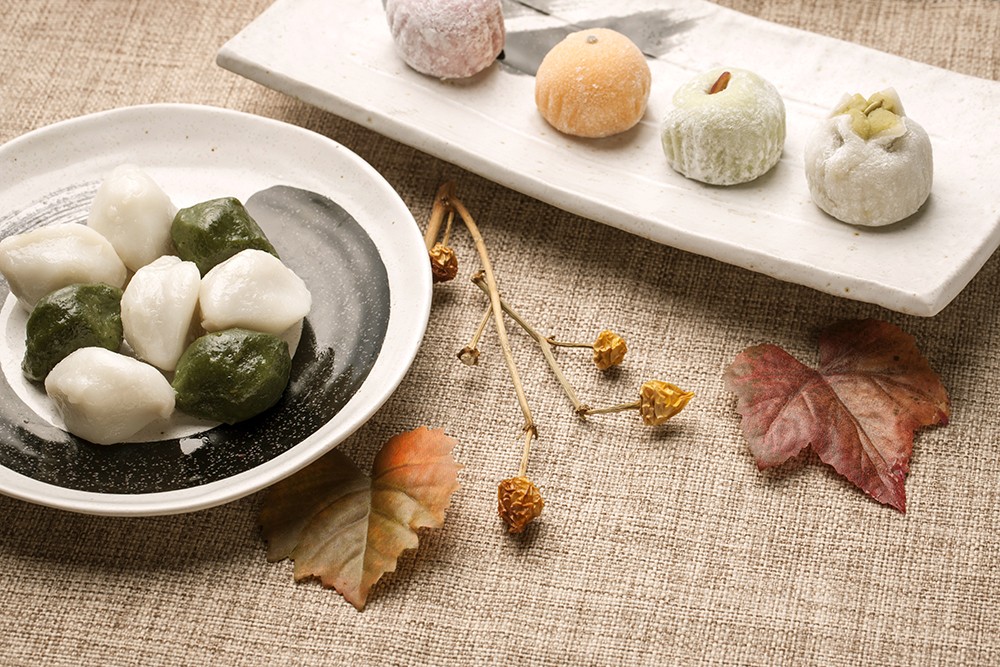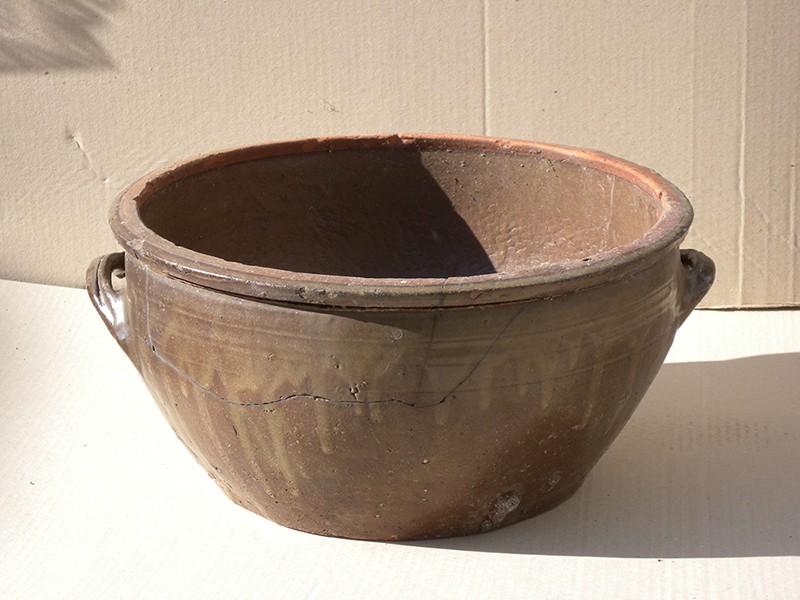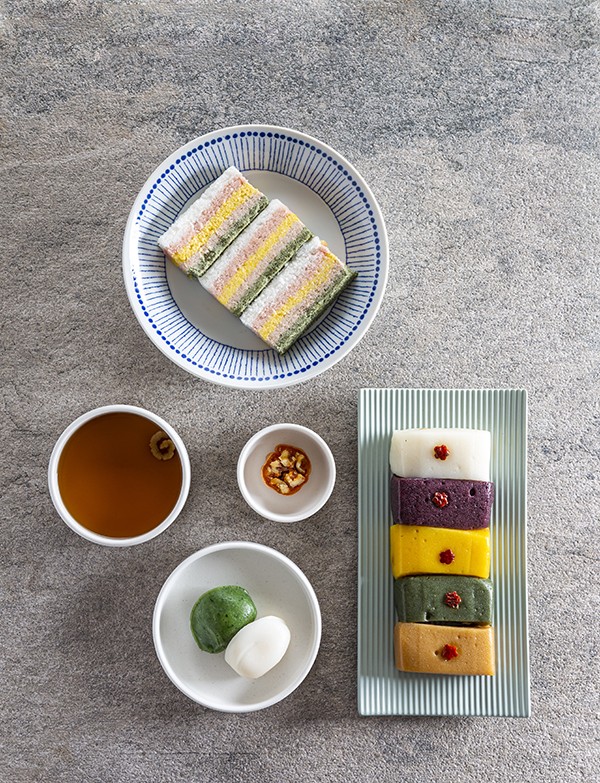한식 읽기 좋은 날
Vol 59. Tteok, an Age-old Korean Delicacy
Four Millennia of History: Tteok, a Healthy Delicacy
Tteok and HANSIK

The history of tteok, or rice cake, in Korea began in the Bronze Age. Over the approximately four millennia that it has been consumed, there are some things about rice cake that have changed, while others have remained the same. Korean rice cakes are not only a healthy snack but also a huge food category whose culture is intertwined with Korean’s daily lives.
Article Seo Dongchul (Editorial Team) Sources Doopedia, Encyclopedia of Korean Culture, K FOOD: Secrets of Korean Cuisine (Design House), Sayings on Korean Food (Park Jeonga and Lee Deokhwa)

Rice with the wooden measuring cup

An earthenware siru (C) National Folk Museum of Korea
A history that begins with rice
Tteok refers to all foods that are made by creating a batter from powdered grain and then steaming, boiling, or grilling it. To extrapolate how long Koreans have been eating rice cake, it is best to start at the point when its main ingredient, rice, was brought to the country and began to be cultivated. Rice and barley, the staples of the Korean diet, are believed to have come to the Korean Peninsula in the Neolithic Age. Grains gained through gathering and primitive farming were ground on a flat stone, after which they were put into an earthenware vessel with water and heated to make a sort of porridge. This method had two disadvantages: the earthenware were not very durable and the grain took on the smell of clay the longer it was boiled.
This porridge evolved into a simple version of the rice cake. Most historians, based on the discovery of siru, or clay pots used to steam rice cakes, among Bronze Age relics, agree that rice cakes began being consumed around this time—which is compounded by the fact that pottery-making techniques advanced greatly during the Bronze Age, resulting in the production of heat-resistant clay cauldrons and siru, which were used to make steamed rice and rice cakes. Given that siru made from brass began to be used around 2,000 BCE, we can estimate that the history of Korean rice cakes is approximately four millennia long. Also, the discovery of siru throughout the Korean Peninsula that date back to the Three Kingdoms Period suggests that, at that point in time, rice cakes were a staple that were consumed in lieu of porridge.
The Iron Age brought about another major change in Koreans’ staple food. It was at this time that agrarian society emerged, bringing about a significant increase in grain production. The advancement of tools, such as the mortar, millstone, and treadmill, for polishing (removing the hulls of) rice led to people eating cooked rice instead of rice cakes: in other words, eating rice grains whole without having to grind them. In the Goryeo dynasty, rice cakes came to be regarded as a delicacy for special occasions.
In Korea, the “golden age” of rice cakes was the Joseon dynasty. Rice cakes were developed into many different formats as an accompaniment for feasts, ancestral rituals, and holiday meals. It was at this time that most of the recipes for the rice cakes we enjoy today were developed.
Over 200 types of rice cakes
The spectrum of Korean rice cakes is as broad as their history is long. In the Joseon dynasty, rice cakes became especially diverse and elaborate due to their inclusion in the many rituals entailed by Neo-Confucianism (the ruling ideology at the time) as well as the advancement of farming technologies. Surviving premodern records—including Sangayorok, the first known Korean cookbook, and Jeungbo Sallim Gyeongje (Revised Farm Management), Gyuhap Chongseo (roughly translated as “Women’s Encyclopedia”), and Eumsikdimibang (first cookbook written in Hangeul, by a woman in East Asia)—contain recipes for over 200 types of rice cakes.
Generally, rice cakes are categorized by cooking method. Steaming, the most common method by far, is done by filling a siru with powdered grain, putting it over a cast-iron cauldron partially filled with water, and then lighting a fire under the cauldron. Examples include sirutteok (steamed rice cake), which is made by lining the siru with layers of different ingredients (e.g. rice powder, red beans, mung beans); seolgitteok, which is made with a single lump of sticky rice that is not pressed into layers; and songpyeon (half-moon rice cake), for which a batter is made with non-glutinous rice and filled with sweetened sesame seeds, chestnuts, and/or other ingredients.
Another frequently-used method is pounding steamed non-glutinous/glutinous rice (or powdered rice) with a long-handled wooden hammer in a mortar or anban, a long wooden plank with a slightly scooped-out center. Pounded rice cakes are known for their chewy texture, the most famous example being garaetteok (rice cake stick), which is cut into coin-like pieces for tteokguk (rice cake soup) on Lunar New Year. There is also jeolpyeon (patterned rice cake), which is made by pouring water over non-sticky powdered rice, steaming it, and then pounding it while adding small amounts of water. Injeolmi (bean powder-coated rice cake) is made by steaming soaked whole sticky rice grains in a siru, pounding it with a hammer until the grains are flattened, and then mixing the result with powdered soybean.
Rice cakes can also be grilled in oil after making a batter by kneading glutinous rice powder with hot water. Collectively referred to as jeonbyeong, the most famous example is hwajeon, or “flower rice cakes,” in which a real flower (usually, pink azalea) is pressed onto a round piece of rice batter. Hwajeon is as delicious as it is aesthetically pleasing. Juak is a rice cake that is made by stuffing a piece of batter with filling, grilling it in oil, and then coating it in honey or grain syrup. It is both delicious and aesthetically pleasing. Bukkumi (pan-fried rice cake) is made by grilling filled pieces of batter made with glutinous powdered rice or sorghum powder.
Gyeongdan (sweet rice balls), like grilled rice cakes, is made with a batter of glutinous rice powder kneaded in hot water. The difference is that the batter is shaped into small, uniformly-shaped balls. Common examples are susu gyeongdan, which is coated in crushed red beans, and samsaek (“three color”) gyeongdan, which is coated in three differently-colored powders such as soybean or black sesame powder. Omegitteok, a rice cake native to Jeju Island made with glutinous black millet, is also a type of gyeongdan.
Rice cakes as a healthy and delicious snack
Rice cakes are equal parts nutritious and delicious because they offer a balance of grain (rice), nuts, beans, wild greens, or fruit. Rice is a source of glucose, which the body uses as energy, and fiber, which helps maintain intestinal health. Glutinous rice is especially effective in protecting the stomach and assisting digestion. Rice is characterized by its relatively small amount of fat and much higher levels of vitamins (e.g. B1, B2) and minerals (e.g. phosphorus, potassium, magnesium, iron). According to one study, rice cakes contain over five times more polyphenol, an anti-oxidant (which is virtually undestroyed during cooking), than grape juice.
Beans, which are usually crushed for use as a coating or garnish, are rich in lysine, an essential amino acid that is not found in rice. Bean-coated rice cakes provide the body with amino acids that are necessary to synthesize protein. Nuts are another favorite coating (e.g. pine nuts, walnuts, chestnuts, sesame seeds) that includes a wide spectrum of nutrients, such as fat, carbohydrates, proteins, vitamins, and minerals.
Koreans’ unending love of rice cakes
Rice cake consumption has decreased somewhat due to the adoption of Western eating habits: namely, preference for flour-based food. Nevertheless, rice cakes are still very much a part of Korean culinary culture. They are still served for Lunar New Year and Chuseok and often distributed to one’s neighbors to celebrate a move to a new home or corporate address. Tteokbokki is still a favorite street snack that is now internationally recognized. Skewered rice cakes are still popular at highway rest stops, and rice cakes are a side for everything from ramyeon to dakgalbi.
The recent interest in physical health is bringing attention back to the rice cake, which has less calories than bread, is filling, and includes all five major nutrient categories (protein, carbohydrates, fat, minerals, and vitamins). Attempts began in the mid-2000s to make rice cakes conducive to modern eating habits, such as the “tteok café” and “fusion rice cakes,” which incorporate ingredients and cooking techniques used for breads. There are also varieties that cater to the tastes of young people, such as rice cake sandwiches (in which bread is replaced with seolgitteok or gijeongtteok), “tteok cakes,” and rice cakes filled with whipped cream. The future of the Korean rice cake, even after 4,000 years, seems to still have great potential.

A variety of rice cake

 한국어
한국어
 English
English






